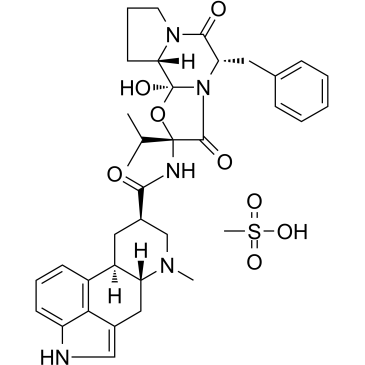24730-10-7
| Name | dihydroergocristine mesylate |
|---|---|
| Synonyms |
dihydroergocristine methanesulphonate
DIHYDROERGOCRYSTINE METHANESULFONATE SALT dihydroergocristine methane sulfonate DIHYDROERGOCRISTINE METHANESULFONATE ERG OT ALKALOID,VASOC Dihydroergocristine mesilate 9,10-DihydroergocristineMethanesulfonate EINECS 246-434-6 dihydroergocristine methanesulfonate salt Dihydroergocristine mesylate,(5'α,10α)-9,10-Dihydro-12'-hydroxy-2'-(1-methylethyl)-5'-(phenylmethyl)-ergotaman-3',6',18-trionemesylate PACAP 1-38 MFCD00153792 dihydroergocristinmesilat DIHYDROERGOCRISTINE MESYLATE dihydroergocristine |
| Description | Dihydroergocristine mesylate (DHEC mesylate) is a inhibitor of γ-secretase (GSI), reduces the production of the Alzheimer's disease amyloid-β peptides, binds directly to γ-secretase and Nicastrin with equilibrium dissociation constants (Kd) of 25.7 nM and 9.8 μM, respectively[1]. |
|---|---|
| Related Catalog | |
| In Vitro | Dihydroergocristine (DHEC) (2-20 μM; 24 hours) has an IC50 value of 25 μM for inhibiting the activity of γ-secretase in T100 cells without affecting cell viability[1]. Dihydroergocristine (2-20 μM; 24 hours) inhibits cellular Aβ production and causes a dose-dependent accumulation of carboxy-terminal fragments of APP (APP-CTFs) in HEK293 and decreases γ-secretase activity in fibroblast cells[1]. Western Blot Analysis[1] Cell Line: WT HEK293 cells; Fibroblast cells Concentration: 2 μM, 5 μM, 10 μM, 20 μM Incubation Time: 24 hours Result: Increased APP-CTFs accumulation in a dose-dependent manner. |
| References |
| Boiling Point | 899.3ºC at 760 mmHg |
|---|---|
| Molecular Formula | C36H45N5O8S |
| Molecular Weight | 707.83600 |
| Flash Point | 497.7ºC |
| Exact Mass | 707.29900 |
| PSA | 180.96000 |
| LogP | 3.50660 |
| Vapour Pressure | 8.49E-35mmHg at 25°C |
| Storage condition | Store at RT |
| Water Solubility | H2O: 10 mg/mL |
CHEMICAL IDENTIFICATION
HEALTH HAZARD DATAACUTE TOXICITY DATA
|
| RIDADR | UN 1544 6 |
|---|---|
| WGK Germany | 2 |
| RTECS | KE7600000 |
| Packaging Group | III |
| Hazard Class | 6.1(b) |
